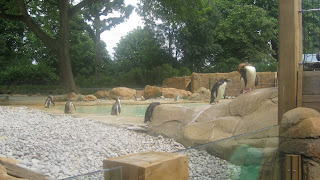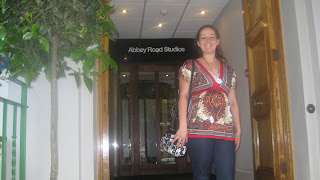On July 2, the whole group went on The Beatles Walking Tour in London. I think technically it’s called the Magical Mystery Tour, but there was no bus involved :) To me, the walking tour and the bus tour are hardly comparable. The bus tour focused on the early lives of the Beatles and how their hometown played such an important role in their song writing. It toured around different places that influenced them as individuals and as a group. However, the walking tour in London brought us to places that the Beatles had a big impact on. Several of the locations were ones that were made popular because of the Beatles’ use for it. It was enjoyable to have such contrasting tours because it gave such a complete spectrum of the influence on the Beatles and their influence on society.
The first location that we were taken to was Paul McCartney’s current London office. I believe MPL stands for Music Publishing Limited. The company was founded by Paul McCartney in the 1970s and the building is still up and running. It is used for publishing music, just like the name states. The objective of this office is to help musicians publish their music, while the agency can also offer suggestions and get the artist on a successful track. The artists sell their work to the agency, but in return are able to reach the full potential of their creativity with some help.
The next location we walked to was Trident Studios. This is the studio where the Beatles recorded Hey Jude. They did a number of recordings at this studio, but several other artists recorded some of their best songs in this studio as well. Other artists that recorded at Trident Studios include James Taylor, David Bowie, Elton John, George Harrison, Ringo Starr, Queen, The Rolling Stones, and many more. This location is not one that the Beatles made popular necessarily because the studio housed many more successful artists. However, this is one of the important landmarks of the Beatles history and their road to success.
Next we walked down Carnaby street. This street is full of hip shops for the young adult population. There are numerous trendy clothing stores, shoe stores, accessory stores, and everything in between. Although the stores are probably not the same companies from when the Beatles shopped along this street, they did make use of the trends of Carnaby. The Beatles, as well as other young celebrities, would shop here to find trendy clothes that not just anyone could buy off the street. Although all the stores were certainly open to anyone who wanted to walk in, they were higher priced and more designer style clothes. Celebrities had the fortune to support these prices, where as the fan base did not necessarily. It soon became known that Carnaby street was the place to go to look like all of the celebrities and the celebrities then started to take their business elsewhere.
Another location we walked to was 3 Sevile Row. This location was very important in the Beatles history. That address was the former location of Apple Studios where the Beatles recorded quite frequently. Besides this being a location that the Beatles utilized for much of their career, it was also a notable spot for the end of their career as the Beatles. The Beatles had stopped performing live several years before they broke up as a band, but during their last year or so, they started filming Let it Be. This was a documentary type film that showed the Beatles in the process of recording an album. Paul had the idea to end the film with a live performance on the roof of Apple Studios. The Beatles had their live performance and performed Get Back, I’ve Got A Feeling, Dig A Pony, Don’t Let Me Down, and perhaps a few others. Although the performance ended with them being asked by the police to stop the concert because they were disrupting the peace, they did gain success from the short concert they gave. Some of the songs were recorded on the roof and those recordings even made it onto the album. This was a very special location to me. I have always been intrigued with the roof-top performance because I wanted to know the meaning behind it. Did they do it just because they felt like it? Were they trying to send out the messages in their songs so everyone could hear without a choice? Was it an attempt to solve continuing issues between the four? Maybe it was a combination of all of the above. That’s what strikes me about the performance. It’s a very cool idea, yet the intent can be left to the audience.
The next and final location we went to on the walking tour was Abbey Road. This is a prime example of a location that became famous because of the Beatles. They recorded at Abbey Road Studios and also shot their easily recognizable cover of the four of them crossing the road in front of the studio. However, Abbey Road Studios was not previously called Abbey Road Studios. It took on that name after the Beatles made such a success out of the album. Before the studio was named Abbey Road, it was called EMI studios.Whether there was much intention behind that photo shoot or not, the Beatles made that location the most photographed location in the world because of that shoot. It is the most recognizable album cover, the most recognizable street, and the most recognizable pose. It is also probably the most annoying intersection for the locals to have to drive through. The location has become so popular that there is a live webcam that runs non stop filming all of the pedestrians crossing the street like the Beatles did. The wall of Abbey Road Studios is completely covered in signatures and messages from fans. Interestingly, the wall is painted over every four months to have a clean slate once again. It’s really fascinating to me that the graffiti is encouraged in this location instead of looked down on and considered illegal. In my opinion, Abbey Road is THE Beatle location in London that is an absolute must.
Our tour was over after Abbey Road, but I tagged along with Mike and a few others to go find some other Beatle locations that we weren’t able to get to. The location that stuck out the most to me in this search was the apartment where Ringo formerly lived. This was also the apartment that Ringo had loaned to John and Yoko. John and Yoko were arrested from this location for possession of drugs and it is also the location where they took the cover shot for their first album together, Two Virgins. What stuck with me the most about this location is that it was marked with the same blue plaque that was on John Lennon’s childhood home in Liverpool. The blue plaque was the exact same one and had John Lennon’s name on it. It struck me as odd that John Lennon’s name was on Ringo’s apartment, but later in the search around London, there was another location with John’s name on it. I was under the impression that the plaque represented the home of that person, but perhaps I was wrong. I still am not quite sure of why that plaque is placed on Ringo’s former home, but I do support the idea of honoring John in important locations in his life, even if it wasn’t his permanent home.
There were several other locations that were important in the Beatles’ history, but this is just an explanation of a few that stood out to me and that I saw as historic landmarks. Again, I enjoyed this tour because it was from an entirely different perspective than the Liverpool tour. In Liverpool, it was about all of the places that made an imprint on the Beatles, but in London, it was about the Beatles making an imprint on us.


















































